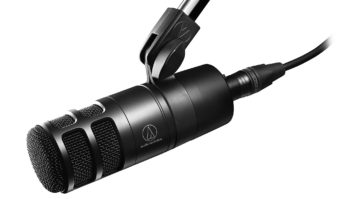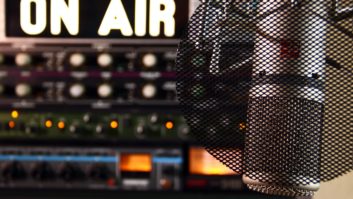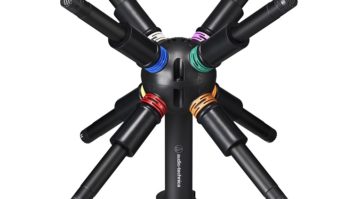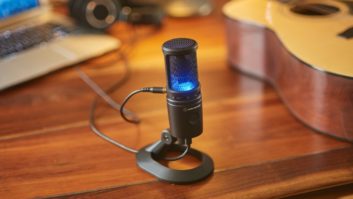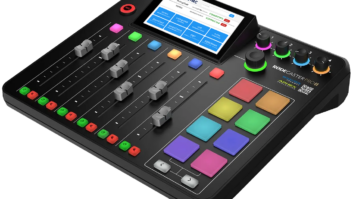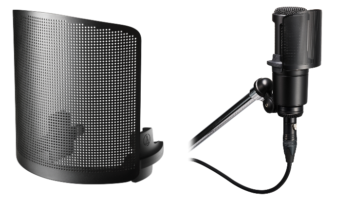Field Report: Audio-Technica AT4040
Apr 1, 2011 1:00 AM, By Gil Wilson

Lately I’ve been looking at microphones I could use as multi-purpose mics and not just for voice or instruments. I had several suggestions for condenser mics, although my preference in a radio production room has always been a dynamic mic. My main problems with condenser mics come down to just two issues: One, they tend to pick up too much sound and I end up cleaning the recorded material before I can do my production; and two, they require phantom power. Most of the stations I’ve worked for don’t have on-air consoles that provide phantom power.
This time around I think I may have overcome my ill-feelings toward condenser mics, and I owe that to the Audio-Technica AT4040.
Performance at a glanceCardioid condenser mic
20Hz – 20kHz frequency response
80Hz, 12dB/octave low-frequency roll-off
10dB pad
100 ohms impedance
Includes shock mount, dust cover and carrying case
The AT4040 is a beautiful mic that performs as well as it looks. Its housing is symmetrical, which provides an open acoustical environment that minimizes unwanted internal reflections. It also includes a switchable 80Hz high-pass filter and features a cardioid pattern. This came in handy when I was recording a group of people for a commercial. They were not broadcast professionals and they all wanted to voice the spot together rather than me mixing down in the audio software. I placed the mic centrally among the three of them and the cardioid pattern eliminated the unwanted room noise and picked them all up with pretty equal strength.
Various uses

Frequency Response. Click to enlarge.
Another test I ran on the mic was recording a band so I could experiment with the sound and functionality. I used it first to just mic the instruments individually, and since it was on my dime, I recorded two instrument amps at the same time. With easy mic placement I found that again this mic saved me time by not requiring the mixing of the two sources. When I compared the two finished audio tracks, there was no difference between the mixing of the two separate tracks (one mic for two instruments, and the two instruments recorded separately). The ability to change the rolloff allowed me to experiment with different sound and frequency changes to find the one that best fit the instruments I was miking. The elimination of low-frequency distortion provided an expanded sound without any clipping from the recording. When I was recording the bass guitar, the sound was full and the ability to cut out some low end with just a switch on the mic made for some clean recordings.
Audio-TechnicaP
W
E 330-686-2600
www.audio-technica.com
[email protected]
My next test was to see how this mic would do as an on-air studio mic. At first I was thinking it might be overkill for this mic, but after the trial I was sold. Our on-air console did not provide phantom power, but soon after borrowing (and later purchasing) an inexpensive phantom power adapter/supply I overcame my phantom power phobia. Monitoring the direct feed and the on-air feed, the sound was incredible: crunchy, crisp, clear and detailed. In fact, when switching the mic back to our regular studio dynamic mic, the sound was muddy.

Our signal processor cleans a lot of the sound before sending out on the airwaves, but with the AT4040, I’m guessing the processor didn’t have to work as much as it did with our dynamic mics. It all comes down to the mic capturing pure natural sound.
I respect the sound the AT4040 provided for the on-air studio, but found this mic to be perfect for the production studio. I used this mic with a variety of mic preamps and every time it provided the clean, wide sound for recording of the non-professionals and the highly desired clarity by the production professional. I never thought of a mic as being a time-saver but this one definitely saved time.
Wilson is an announcer, producer, webmaster and promotions guy at WAKO-AM/FM, Lawrenceville, IL.
Editor’s note: Field Reports are an exclusive Radio magazine feature for radio broadcasters. Each report is prepared by well-qualified staff at a radio station, production facility or consulting company.
These reports are performed by the industry, for the industry. Manufacturer support is limited to providing loan equipment and to aiding the author if requested.
It is the responsibility of Radio magazine to publish the results of any device tested, positive or negative. No report should be considered an endorsement or disapproval by Radio magazine.
April 2011
HD Radio monitors ,choosing an audio over IP network switch, a look at the Clear Channel Chicago rebuild, transmission line pressure monitoring, and Field Reports on the FM Services TLM-1 and Audio-Technica AT4040….





